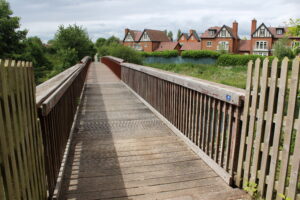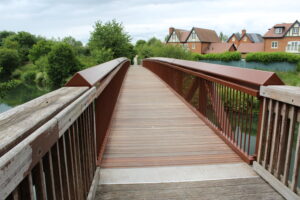Berry Hill Footbridge (Jubilee River Bridge Number 2) on the Thames Path has been closed for years. The centre section of the wooden bridge has now been replaced with a steel bridge.


Sadly only the centre section of the bridge has been replaced with steel. The two end sections have been left as original timber dating from 2002 or earlier. Total costs for removal of the old timber bridge central section and installation of the steel replacement could be around £440,000 – and paid for by the local authority – not the EA.
Now here come the problems. Firstly the timber decking on the two remaining original sections is well rotted in places. I suspect that a timber construction was specified to meet cost reduction targets. The original (last century design) material specification and with minimal maintenance since – the actual life of the original footbridge was only about 20 years when compared against the MWEFAS project life of 50 years.
Question 1 – I accept that the original bridge was rotten but who decided to replace only the centre section rather than the entire footbridge?
Question 2 – There are a number of other wooden footbridges over the Jubilee River and further downstream in a similar condition i.e. approaching the end of design life. Who is taking what action to ensure that those bridges are not out of action for years while they are replaced – and of course – who pays? Why was responsibility for these structures transferred to the local authority?
All comments welcome and gratefully received.
END


Retaining the original timber abutments which show some evidence rot/deterioration with a new steel centre section gives rise to the question of weight difference between steel and wood with time erosion of the end supports . Is this not a health and safety issue. Who has signed off the work and for what organisation.
Should there be a future issue then this info would be required for evidence.